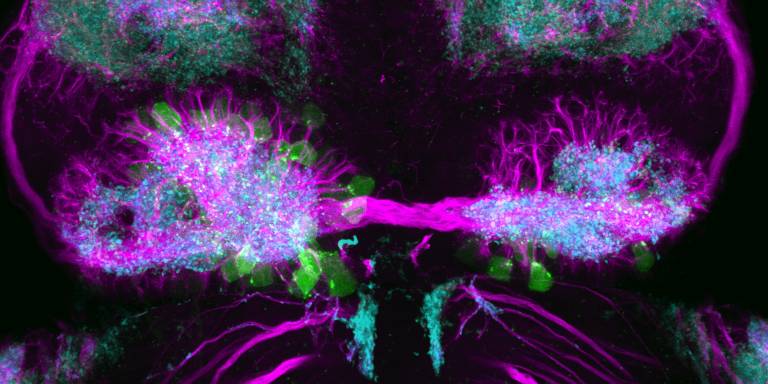Left side story: new insights into the genetics of brain asymmetry
3 May 2024
Differences between the left and right sides of the nervous system are seen in all animals, including humans. This study reveals a new piece in the puzzle of how such asymmetries can arise.

The human brain is divided into left and right hemispheres that superficially look like mirror copies of each other. However, there are differences between the sides that ultimately affect the types of neural connections formed and, as a consequence, the way our brain processes information and controls our behaviour. How do asymmetries between left and right sides of the brain arise? In a collaborative study, Powell and colleagues find that if a gene called cachd1 fails to function in zebrafish, then a part of the brain called the habenula loses asymmetry with neurons on the right developing with left-sided identity. This loss of asymmetry changes the neural connections of the habenula and consequently will disrupt the function of this conserved brain structure.
To find out how Cachd1 functions, the investigators performed experiments to uncover the proteins it binds to and identified two receptors that allow cells to respond to signals called Wnts. This was consistent with other research by these and other investigators that has found that other genes in the Wnt signalling pathway can affect brain asymmetry. One intriguing finding in the study is that Cachd1 is present and can function on both sides of the brain, but its activity is blocked by a mystery signal on the left thereby triggering left/right asymmetry. The future identification of this mystery signal will be an important next step in unravelling the mechanisms by which the brain acquires these asymmetries.
Wnt signalling is one of the most intensively studied pathways by which cells talk to each other and so it is exciting and surprising to find a new gene functioning in this pathway. Wnt signalling is involved in many biological processes including embryonic development and stem cell biology and disruptions to this pathway are observed in many cancers, neurological conditions and other diseases. Consequently, in future research it will be important to address if Cachd1 plays key roles in other contexts in which the Wnt pathway is a key player.
Co-first author Dr Gareth Powell (UCL Cell & Developmental Biology) said: "This was a very collaborative project that benefitted greatly from a cross-disciplinary approach - genetics, biochemistry and structural biology coming together to better understand the establishment of left-right asymmetry in the brain, as well as identifying a new component of an important signalling pathway that has many roles in health and disease."
Co-senior author Professor Steve Wilson (UCL Cell & Developmental Biology) said: "Really happy to see the publication of this highly collaborative study that has brought together many talented people with varied research interests and skills from multiple institutes. Together, the team have allowed us to make exciting new insights into both Wnt signalling and the development of brain asymmetry."
Co-senior author Professor Yvonne Jones (University of Oxford) said: "I am very excited that by taking this wide-ranging interdisciplinary approach we have been able to open up a new perspective on the regulation of neuronal asymmetry."
Further information:
- Research paper in Science
- Dr Gareth Powell’s academic profile
- Professor Steve Wilson’s academic profile
- Wilson lab at UCL
- Jones Group: Receptor Structure Research at the University of Oxford
- Li lab at the Francis Crick Institute
- Wright lab at the University of York
- Raible lab at the University of Washington
Image:
Image of the left and right habenula in the brain of a young zebrafish fry. The neurons (green), neuronal processes (magenta) and synaptic connections (blue) show asymmetries between left and right sides. Image Wilson lab (Ana Faro and Tom Hawkins)
Contact:
Gareth Powell - g.powell [at] ucl.ac.uk
Steve Wilson - s.wilson [at] ucl.ac.uk
X/Twitter - @stevewilsonfish
 Close
Close

